Vienna, Austria's capital, is home to an array of historic sites and cultural treasures, but none quite capture the imagination like Schönbrunn Palace. This magnificent palace, with its stunning architecture and expansive gardens, stands as a testament to the country's imperial past and its enduring appeal to visitors from around the globe.
Note: This article contains affiliate links. In case you purchase something through one of these links, we may receive a small commission at no extra cost for you. Thank you for helping us keep creating the free content on this website!
Introduction to Schönbrunn Palace
Schönbrunn Palace in Vienna stands as a remarkable symbol of the rich cultural heritage and architectural ingenuity of Austria. This magnificent baroque palace, with its history dating back to the 17th century, served as the summer residence of the Habsburg rulers. It is not just a monument but a sprawling estate that encapsulates the splendor and opulence of an era gone by. With its 1,441 rooms, each decorated with meticulous attention to detail, Schönbrunn Palace offers a fascinating glimpse into the lives of the European aristocracy.
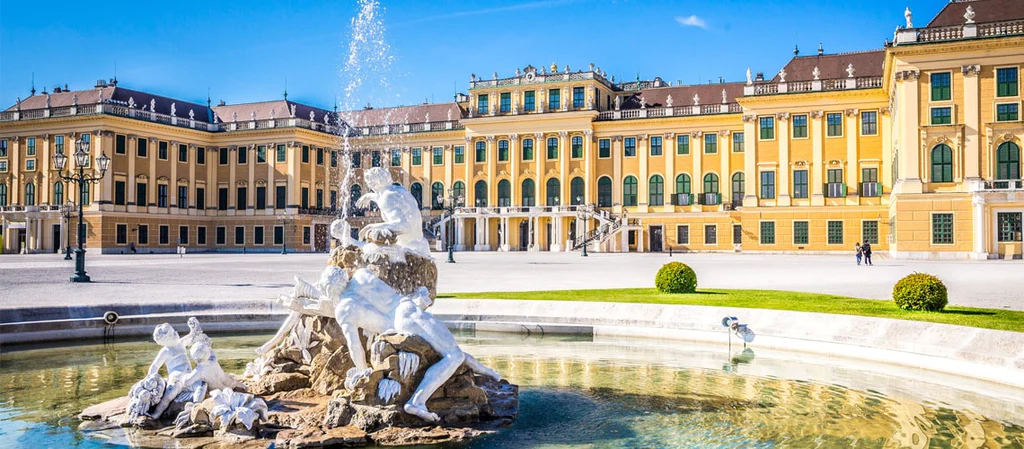
Nestled in the heart of Vienna, the palace is surrounded by beautifully landscaped gardens, which include the famous Gloriette, a marble summerhouse situated on a hilltop, offering panoramic views of the palace and its gardens. The gardens themselves are a masterpiece of landscape architecture, featuring an array of sculptures, fountains, and the world's oldest zoo, which was founded in 1752 as an imperial menagerie. The combination of its stunning architecture, historical significance, and the natural beauty of its gardens makes Schönbrunn Palace in Vienna a must-visit destination for anyone interested in the cultural heritage of Europe.
Over the years, Schönbrunn Palace has not only been a residence but also a cultural and political hub. It has witnessed numerous historical events and hosted many significant figures, including composers like Mozart, who performed here as a child. Today, it is a UNESCO World Heritage Site, attracting millions of visitors from around the globe. The palace's architecture, with its ornate decorations, intricate frescoes, and elaborate gardens, showcases the artistic and architectural prowess of its time, making it a lasting testament to the legacy of the Habsburg monarchy.
Brief History of the Schönbrunn Palace in Vienna
The narrative of Schönbrunn, weaving through the tapestry of time, begins in the medieval era, tracing back to lands once christened Katterburg in the early 1300s, nestled within the dominion of Klosterneuburg Abbey. This expanse, rich in its offerings, boasted a corn-mill, arable lands, and vineyards, painting a picture of rustic abundance. As the centuries unfolded, a mosaic of lessees emerged, with 1548 spotlighting Hermann Bayer, Vienna's mayor, who ambitiously expanded these grounds into a distinguished country retreat.
The year 1569 marked a pivotal chapter when the Habsburgs, through Maximilian II, embraced the estate, enriching it with a residence, watermill, stables, a pleasure garden, and an orchard. Maximilian's vision primarily sought to magnify the game park, a sanctuary for native and exotic breeds alike, including peacocks and turkeys, weaving a narrative of royal indulgence and natural splendor.
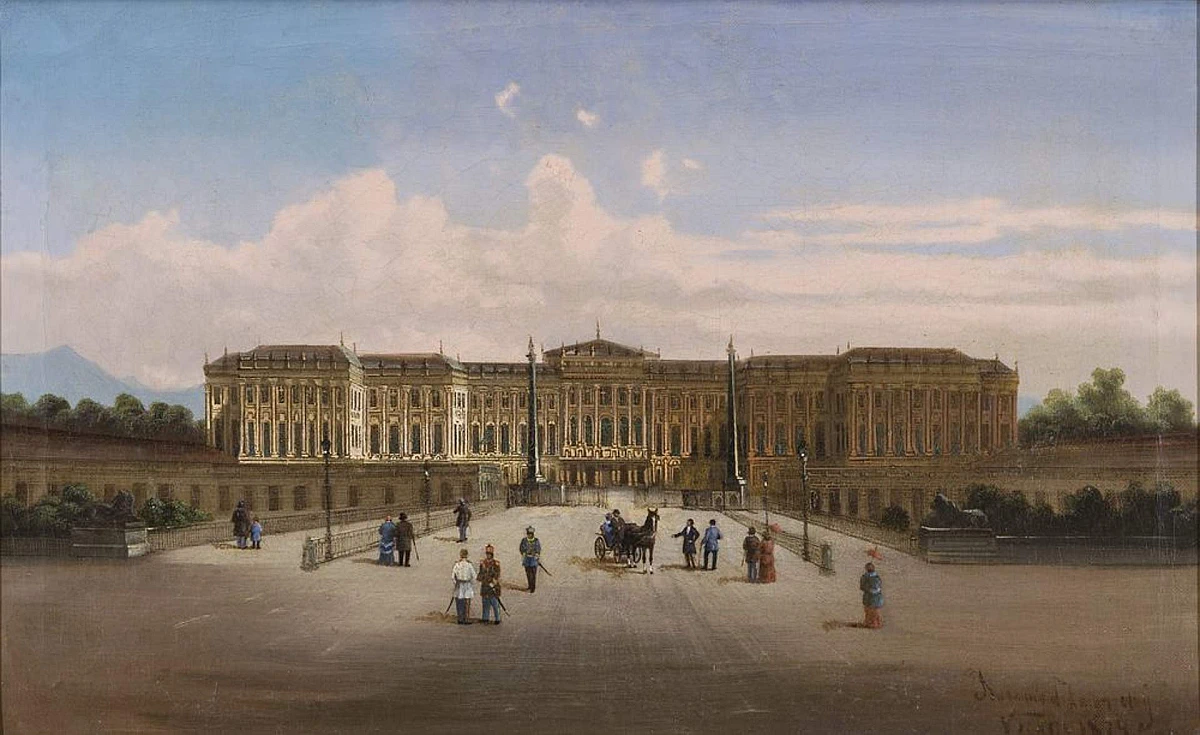
The curtain fell on Maximilian II in 1576, transitioning the Katterburg to Rudolph II, whose contributions whispered of maintenance rather than transformation. It was during Emperor Matthias's reign that a legend bloomed around the discovery of the Schöner Brunnen ('fair spring'), birthing the estate's renowned name during a hunting venture in 1612.
The saga continued under Emperor Ferdinand II and Eleonora von Gonzaga, united in their passion for the hunt, choosing Schönbrunn as the backdrop for their regal pursuits. Following Ferdinand’s demise in 1637, the estate transitioned into a widow's dower residence, necessitating an architectural masterpiece to host Eleonora's vibrant social tapestry, culminating in the erection of a château de plaisance by 1642 and the christening of Katterburg as Schönbrunn.
The year 1683 witnessed the château and its deer park succumbing to the siege of Vienna's turmoil. By 1686, the narrative shifted to Emperor Leopold I's vision, gifting the estate to his heir, Joseph, and commissioning the architectural prodigy Johann Bernhard Fischer von Erlach. With the unveiling of the Schönbrunn I Project in 1688, Fischer's architectural narrative sought to captivate the emperor, securing his role as the court's architectural luminary, etching his legacy into the heart of Schönbrunn’s historical tapestry.
In the year 1693, the intricate blueprint for a magnificent hunting lodge sprang to life under the direction of Leopold I, entrusting Fischer with its design. Ground was broken in 1696 on the project, incorporating the remains of a château previously enjoyed by the dowager empress, which had met its demise at the hands of the Turks. By the dawn of 1700, the lodge's heart stood complete, ready to embrace its inhabitants.
Yet, the wings that would stretch out from its core found their birth delayed until 1701, hindered by the turmoil of the War of the Spanish Succession and the financial drought that accompanied it. The work ground to a halt with the unexpected passing of Joseph. Fischer von Erlach, the visionary behind the lodge, not only sketched the outlines of this grand abode but also oversaw every hammer and chisel, earning him noble recognition from Emperor Leopold, henceforth known as Fischer von Erlach.
This creation diverged significantly from Fischer's initial dream, a utopian vision of grand entrances, colonnades, and water features from the river's edge to the palace peak. Instead, this lodge nestled at the hill's base, embodying the grandeur of Baroque symmetry around a central spine.
The palace presented itself as a solid mass, its central facade crowned by a grand stairway, its arms extended into wings housing the stables. Encircling a courtyard of honor, which culminated in an obelisk gate crowned by an eagle, statues depicting Hercules' trials stood guard.
Within this regal lodge, the state rooms faced the courtyard, with Joseph I’s private quarters tucked away in the west wing, overlooking the gardens, and guest accommodations in the east. A planned Empress Stairway in the west wing hinted at future expansions, promising access to the empress’s chambers.
The palace boasts an impressive total of 1,441 rooms, showcasing the grandeur and opulence of the Habsburg monarchy. However, of these many rooms, only 45 are accessible to the public.
The lodge, left unfinished, became the refuge of Wilhelmine Amalie until Emperor Charles VI, captivated by its charm for mere pheasant hunting, bestowed it upon his daughter, Maria Theresa. Her era ushered in a golden age for Schönbrunn, transforming it into a political and social nexus. Under her gaze and Architect Nikolaus Pacassi's guidance, Joseph I’s lodge flourished into a summer palace, a testament to Maria Theresa's deep-seated affection for its halls and gardens.
The Majestic Gardens of Schönbrunn Palace
The gardens of Schönbrunn are a masterpiece of landscape architecture. The Gloriette, perched on a hill, offers breathtaking views of the palace and its surroundings. Meanwhile, the maze and labyrinth invite visitors to lose themselves in their intricate paths, and the Orangery stands as a reminder of the palace's connection to nature and cultivation.
These sprawling gardens, designed in the Baroque style, extend over an impressive area, offering visitors a glimpse into the past through their meticulously planned landscapes and architectural features.
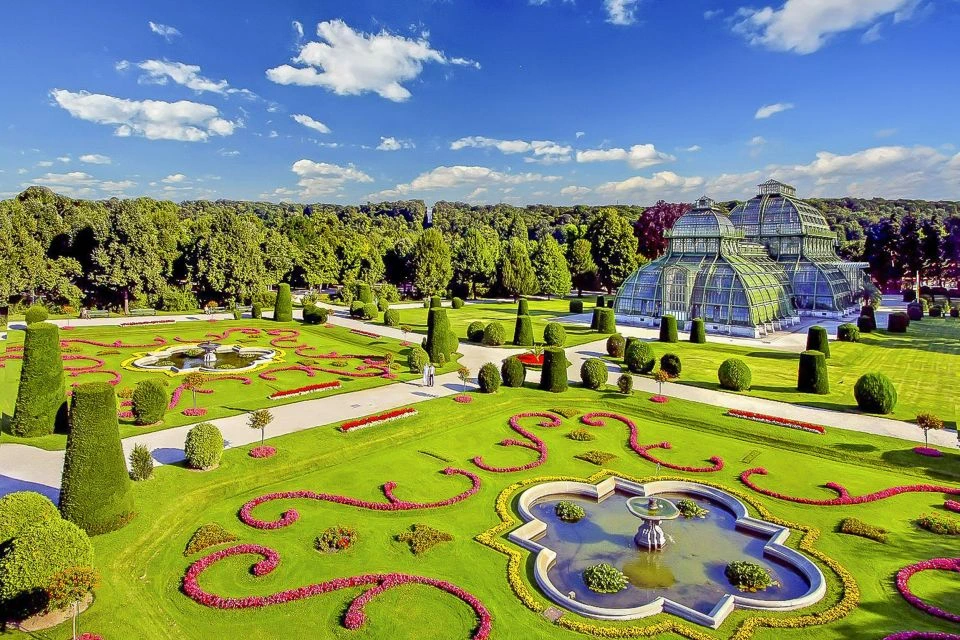
At the center of this verdant expanse lies Schönbrunn Palace in Vienna, a UNESCO World Heritage site, surrounded by a myriad of attractions including the Neptune Fountain, the Roman Ruin, and the Gloriette, a grand structure located on a hilltop overlooking the palace and its gardens. The design of the gardens reflects the Baroque love for symmetry, precision, and order, combined with a fascination for exotic plants and elaborate sculptures. The Great Parterre, a vast patterned garden, and the meticulously maintained hedges and flowerbeds demonstrate the gardening prowess of the time.
The Schönbrunn Palace gardens also house the world’s oldest zoo, the Tiergarten Schönbrunn, which was founded in 1752. This adds another layer of historical and educational value, making the gardens not only a place of beauty but also a center for conservation and learning. The Palm House, another highlight within the gardens, showcases an impressive collection of tropical plants, underlining the Habsburgs’ interest in botany and the sciences.
Visiting the Majestic Gardens of Schönbrunn Palace offers a retreat into a world where nature and culture intertwine seamlessly. It's a place where history is palpable, and the beauty of the natural world is celebrated with every step. These gardens are not just a part of Schönbrunn Palace in Vienna; they are a living, breathing monument to the sophistication and elegance of an era gone by, inviting exploration and admiration from all who walk their paths.
Nestled within the expansive grounds of Schönbrunn lies a captivating trio of hedge mazes, each presenting its own unique challenge. Among them, a particularly intriguing maze beckons adventurers to navigate its twists and turns, all in pursuit of the elusive viewing platform nestled at its heart. This delightful labyrinth offers more than just a test of direction; it invites a shared moment of triumph as you gaze upon the befuddled wanderers below, echoing the laughter of those who have stood before you. Beyond the leafy confines of these mazes, a quaint playground offers a reprieve for the young and young at heart. A nominal admission fee of 5 EUR applies to all in 2023, with a special bundle available that includes access to the children's museum for a total of 11 EUR. It's important to note that the standard Schönbrunn entry pass does not grant access to this enchanting world of mazes. These verdant puzzles await your arrival from April 1st to November 2nd, promising a blend of challenge, amusement, and a touch of whimsy.
Neptune Fountain
In the heart of this scene, the wall breaks open to reveal a forward-jutting, half-moon base, from which emerges a rugged terrain, alive with the presence of Neptune, the god of the sea, and his followers. The base and the wall behind it are segmented by unadorned panels, those on the base adorned with decorative masks, and the dividing uprights are draped with festoons.
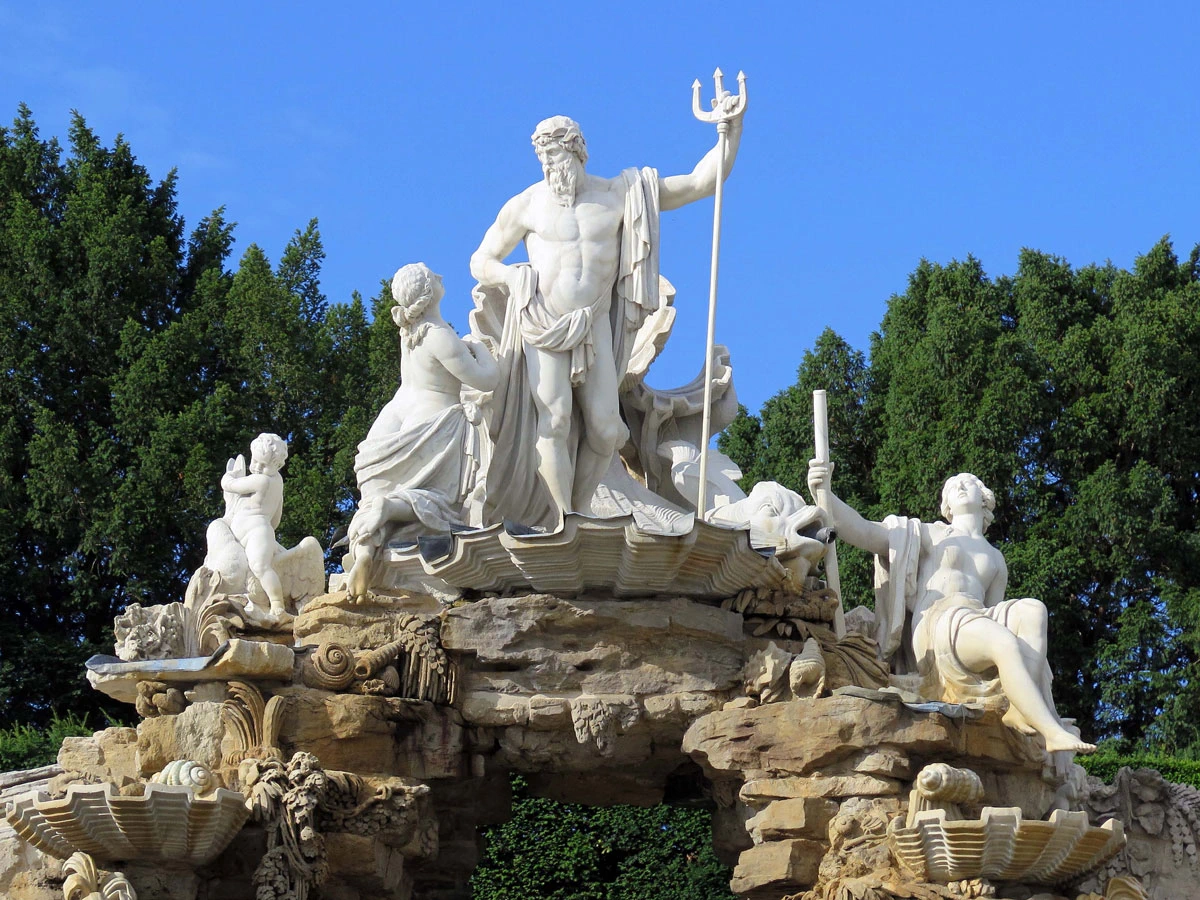
Above, crowning a craggy cavern, Neptune commands attention in his shell-inspired chariot, trident poised. To his left, a nymph stands by, while to his right, the sea-goddess Thetis kneels, pleading with Neptune to ensure the success of her son Achilles' journey to Troy. At their feet, the Tritons, half-man, half-fish beings of Neptune's retinue, frolic. They clutch conch shells, their tones capable of striking dread into hearts of both mortal and beast, as they corral the sea-horses that pull Neptune’s chariot through the ocean's expanse.
The depiction of Neptune reigning over the ocean's vastness, a vision recurrent in art from the sixteenth to the eighteenth century, symbolizes monarchs' command over the fate of their realms.
Roman Ruin
In a bold nod to antiquity, Hohenberg orchestrated the creation of the Roman Ruin at Schönbrunn, drawing inspiration from the ancient Roman temple dedicated to Vespasian and Titus. This vision was fueled by an engraving from Giovanni Battista Piranesi, dating back to roughly 1756, capturing the temple's remnants in haunting detail.
Diverging from the Gloriette's architectural narrative, this structure's every element — from columns to reliefs — came to life under the keen eye of the court architect, a fact confirmed by recent findings. Artisans Beyer, Henrici, and Franz Zächerle lent their skills to the stone adornments, while materials from the dismantled Neugebäude palace were repurposed to enhance the surrounding decorative stonework.
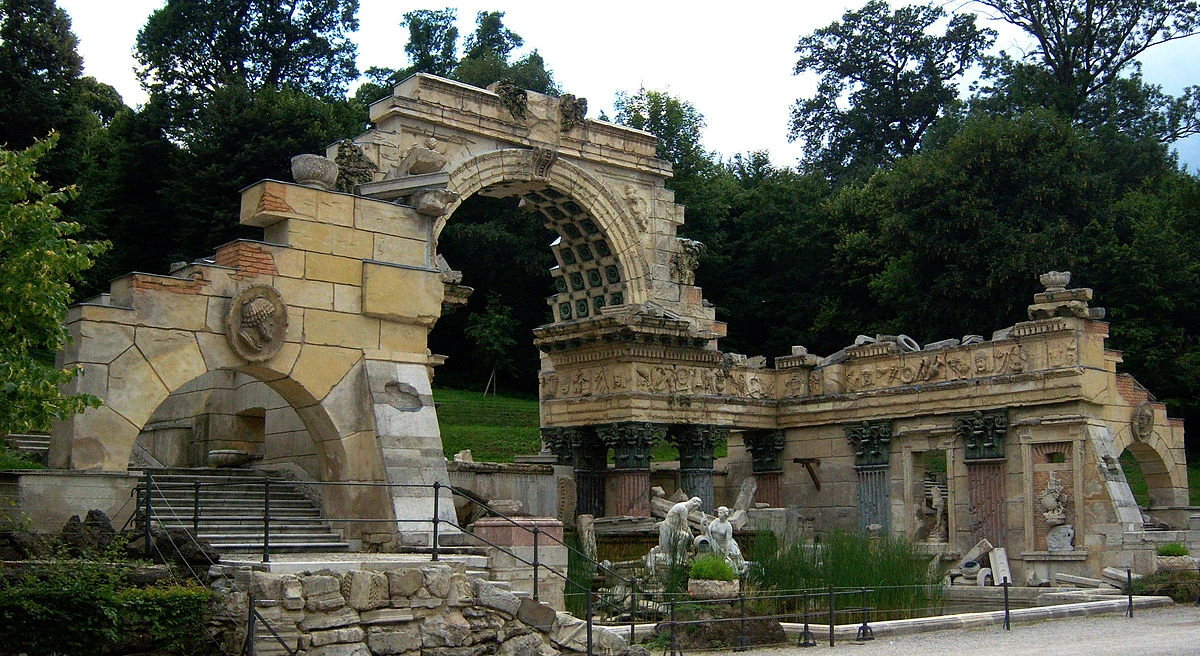
The ruin's design features a grand rectangular pool, its tranquility disrupted by a towering semi-circular arch and walls that lean into the illusion of a once-majestic building now yielding to time. The arch stands proud at the center, its broken architrave and frieze adorned with reliefs depicting ritual instruments drawn from Roman antiquity. Flanking walls extend, showcasing similar reliefs alongside Classicist sculptures and busts.
Guarding the pool's edge, a sculptural ensemble by Wilhelm Beyer depicts the river gods Danube and Enns, adding a mythological layer to the waterscape.
Behind this central arch, a path once terraced like a cascading waterfall leads to a scene of mythic struggle: Hercules in combat with Cerberus, guardian of the underworld's gates, and the multi-headed Hydra at his feet, symbols of Herculean might and mythological virtue.
Beyond its picturesque allure, the ruin's informal title, "Ruin of Carthage," hints at a deeper symbolism — perhaps evoking Rome's triumph over Carthage. This aligns with the Habsburg dynasty's self-image as heirs to the Roman Empire, positioning the ruin as a testament to their historical and dynastic aspirations.
Orangery Garden
Designed in the mid-18th century by Nicolaus Pacassi, the Orangery at Schönbrunn stretches an impressive 189 meters in length and 10 meters in width. It stands out as the most grandiose Baroque orangery in Europe, second only to its counterpart in Versailles.
The orangery's western end still plays a crucial role today, providing a winter refuge for a collection of exotic plant species. With the arrival of warmer weather, these botanical treasures are relocated throughout Schönbrunn's expansive gardens.
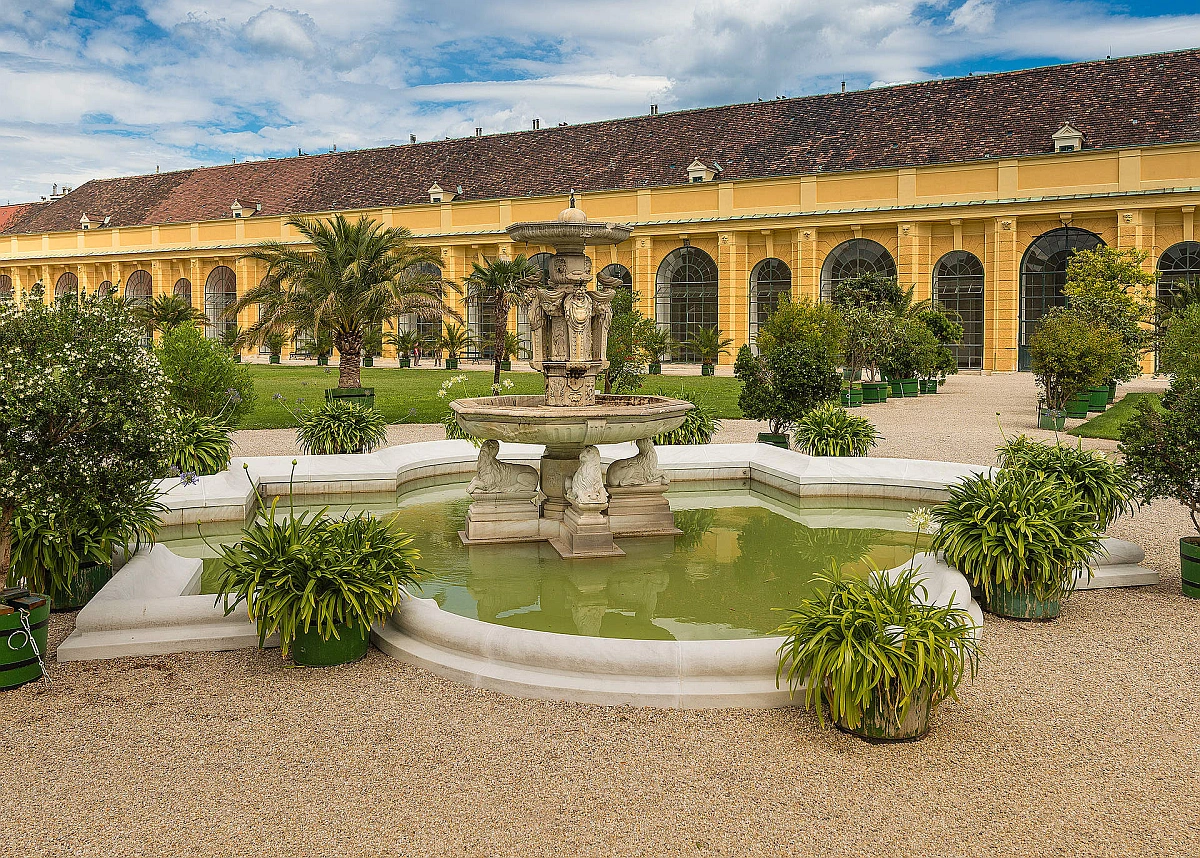
Step into this architectural marvel to discover the still-functioning original hypocaust heating system. This ancient technology maintains a steady warmth of about 10º Celsius through the colder months, creating a haven for the plants.
Allow the Orangery Garden to enchant you with its array of precious exotic flora, including the likes of pomegranates, olive trees, and myrtles. As you wander amongst these botanical wonders, take a moment to reflect on the early chapters of European horticulture history.
Gloriette
Since its inception in the early 1800s, the Gloriette has beckoned visitors to ascend its stairway and stand atop its roof, offering an unparalleled vista. This architectural marvel, with its central portion echoing the grandeur of a triumphal arch and ensconced between wings of rounded arches and arcades, invites the eye and the spirit alike.
Encircled by a balustrade, the flat rooftop has long served as a bastion for breathtaking views, a tradition that continues to this day. Modern explorers are welcomed to tread the same steps, to behold the sprawling beauty of Schönbrunn and vast stretches of Vienna beyond. Within the heart of the Gloriette, now lies a café, its glass walls offering a respite amidst the majesty of history and the embrace of the horizon.
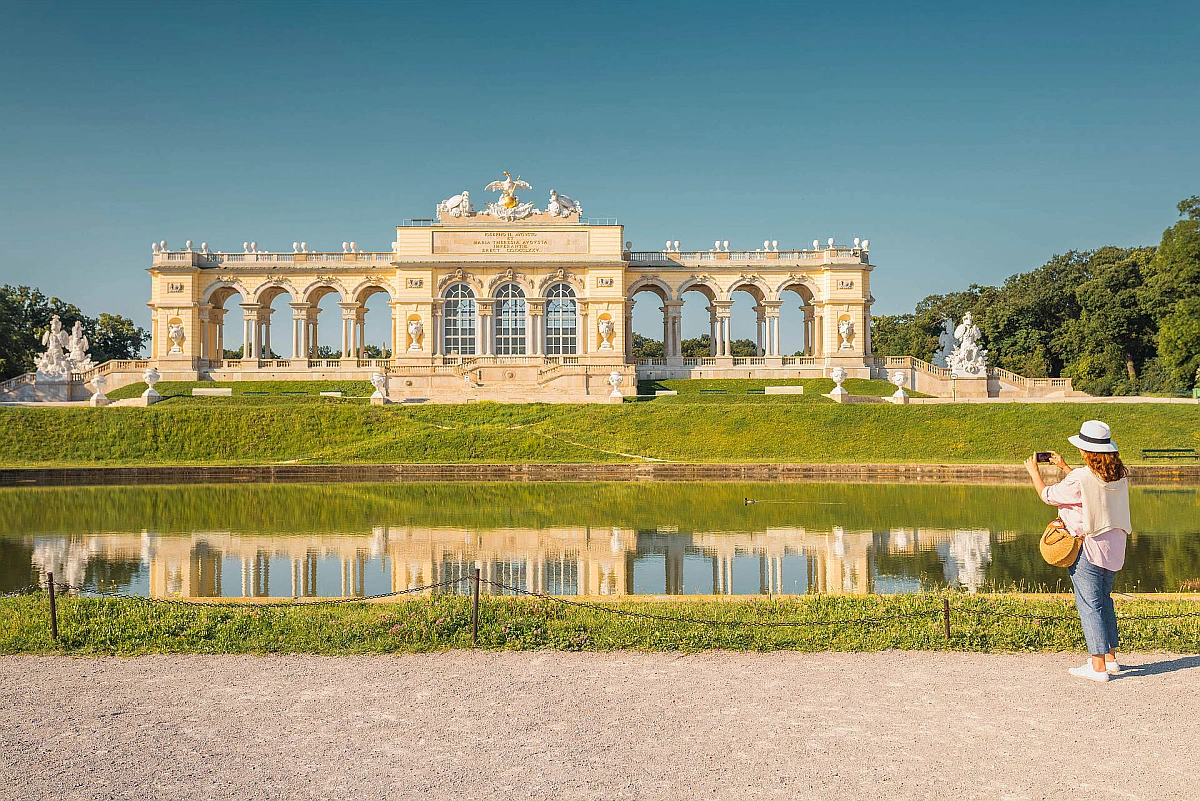
Inside Schönbrunn: A Tour of the Imperial Rooms
Stepping inside Schönbrunn Palace is like walking through history. The Grand Gallery impresses with its lavish decoration, serving as a reminder of the palace's role in hosting state functions. The Marie Antoinette Room, with its delicate furnishings, offers a glimpse into the personal lives of the royalty, while the Napoleon Room serves as a testament to the palace's significance in European politics.
This historical edifice, with its baroque architecture and beautifully landscaped gardens, stands as a testament to the lavish lifestyle and political power of the Habsburg rulers who resided there. The palace, with its 1,441 rooms, each tells a story of artistic excellence, political intrigue, and personal tastes of the emperors and empresses who called it home.
The tour of the imperial rooms at Schönbrunn Palace in Vienna is a journey through time, offering visitors an intimate look at the private and state apartments of Emperor Franz Joseph and Empress Elisabeth (Sisi), among others. The ornately decorated rooms, filled with exquisite furniture, elaborate tapestries, and stunning frescoes, reflect the eclectic tastes of the Habsburgs, ranging from Rococo to Neoclassicism. The Mirror Room, where six-year-old Mozart performed for Empress Maria Theresa, and the Great Gallery, used for courtly balls and banquets, are highlights, showcasing the splendor of 18th and 19th-century aristocratic life.
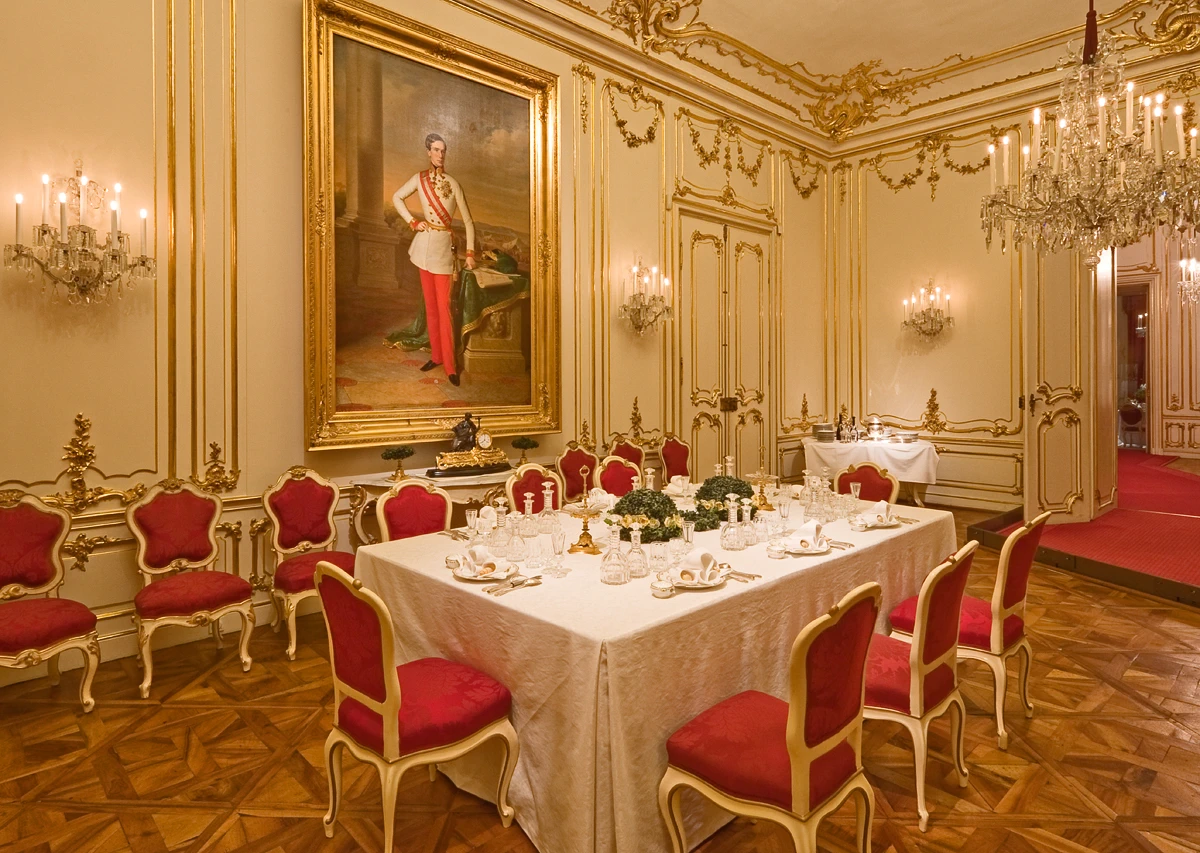
Beyond the imperial apartments, the tour offers insights into the daily lives of the palace's inhabitants, including the challenges of managing such a vast estate. The meticulously maintained gardens, the Gloriette with its panoramic views of Vienna, and the world's oldest zoo within its grounds, emphasize the palace's role as a center of culture, science, and leisure. Inside Schönbrunn: A Tour of the Imperial Rooms not only celebrates the architectural and artistic achievements of the past but also invites reflection on the complexities of history and the narratives of those who shaped it.
Cultural and Musical Heritage
Schönbrunn is synonymous with music and culture. The annual Summer Night Concert and performances of Mozart's works in the Orangery are just a few examples of how the palace continues to be a beacon of cultural heritage, celebrating Austria's rich musical history.
Schönbrunn Zoo: A Modern Ark
Adjacent to the palace, the Schönbrunn Zoo is the world's oldest existing zoo and a leader in conservation and species preservation. It's home to a diverse array of animals and is committed to educating the public about biodiversity and the importance of protecting natural habitats.
Nested within distinct compartments, each boasting its own source of water, were enclosures, their separation marked by towering walls. A contrasting openness was offered by the railings that divided them from the central gazebo, these barriers adorned with vases and animal sculptures, inviting onlookers into a world both seen and unseen. The enclosure's rear sheltered a cabin-like structure, a nocturnal refuge for its animal inhabitants. To the west, nestled lower, a building rose, purposed for the caretakers' lodging, overlooking a pond designed for the aquatic birds to roost.

Nestled within its historic walls, yet vibrantly alive with contemporary care, the Vienna Zoo is a place where the charm of its residents - from the majestic giant pandas, a rarity among European zoos with only six hosting these peaceful creatures, to the playful orangutans, the regal lions and tigers, the towering giraffes, the striped zebras, the cuddly koalas, the barking sea lions, the waddling penguins, and the stoic polar bears - truly comes to life, especially during the mesmerizing feeding times.
These moments, a spectacle of nature's rhythms, are outlined on an information sheet available at the entrance, along with a detailed map to navigate the zoo’s expanse, though you're invited to peek online for a sneak preview. Beyond the zoo's gates lies the desert house, a separate realm that promises an immersive journey into the arid heart of the desert, showcasing its unique flora and fauna (note: entry to this zone requires a combined ticket). And for those wishing to glide through the zoo's vast landscapes with ease, a quaint train awaits to ferry visitors through this animal kingdom from April to November, at an additional fee of $9, offering a rolling embrace of this enchanting sanctuary.
The heart of this architectural marvel was the singular, ground-level gazebo, occasionally serving as the breakfast spot for the imperial duo, strategically positioned to command attention along the palace's grand diagonal axis. This gazebo, perched atop an octagonal base, welcomed visitors through four gateways.
Projected from the gazebo's core, four facades featured arched entrances and pediments, the latter embellished with figurative art. Windows, set in arched niches, punctuated these expanses, under a dome that mirrored a bell, its summit encircled by a balustrade. Inside, a transformation post-1765 by Maria Theresa's command, from green to a sanctuary memorializing her spouse, with opulent wooden decor, mirrors, and paintings by Johann Michael Purgau of rare fauna - a blend of reality and aspiration, as revealed by modern studies. The ceiling, a canvas for Josef Ignaz Mildorfer, depicted mythological transformations from Ovid's tales, where mortals meld into the animal realm amidst Bacchus and Ariadne's revelries.
The genesis of Schönbrunn's animal haven traced back to Neugebäude Palace's legacy and the Belvedere menagerie, excluding predatory beasts, rehomed to Schönbrunn. The collection burgeoned with new finds and gifts, enriched by expeditions under Franz Stephan's patronage to the West Indies, enhancing both the zoological and botanical treasures.
With the gardens' opening in 1779, the menagerie welcomed the public, its growth and care overseen by Joseph II, despite challenges in animal husbandry leading to losses. The 19th century saw the collection diversify further, adapting and expanding habitats for its growing menagerie, including the introduction of elephants, camels, and kangaroos, and the spectacle of the first giraffe in 1828, a gift that captivated Vienna and influenced its cultural fabric, despite its brief life.
Schönbrunn Palace has been home to many, yet it's Empress Elisabeth, known as Sisi (1837-1898), who captures the most attention. Adored by the people of Austria, Sisi's tale is paradoxically marked by profound unhappiness, setting her apart as one of history's most sorrowful monarchs.
As the 19th century waned, Schönbrunn's menagerie underwent a transformation, evolving into a modern zoological garden. The old barriers gave way to bars in 1880, enhancing visibility and interaction. Expansion continued, stretching east to the Neptune Fountain, ensuring better conditions for the inhabitants. By 1914, the zoo housed 3,470 animals, marking the zenith of its population.
Seasonal Events and Festivities
Seasonal Events and Festivities at Schönbrunn Palace in Vienna offer visitors a unique opportunity to experience the historical and cultural magnificence of this iconic landmark in a festive atmosphere. Throughout the year, the palace and its expansive gardens serve as a magnificent backdrop for a variety of events that celebrate the changing seasons and highlight Austria's rich cultural heritage. From springtime Easter markets to summer concerts, and from autumn harvest festivals to enchanting Christmas markets, each event at Schönbrunn Palace is a testament to its enduring appeal and the vibrant cultural life of Vienna.
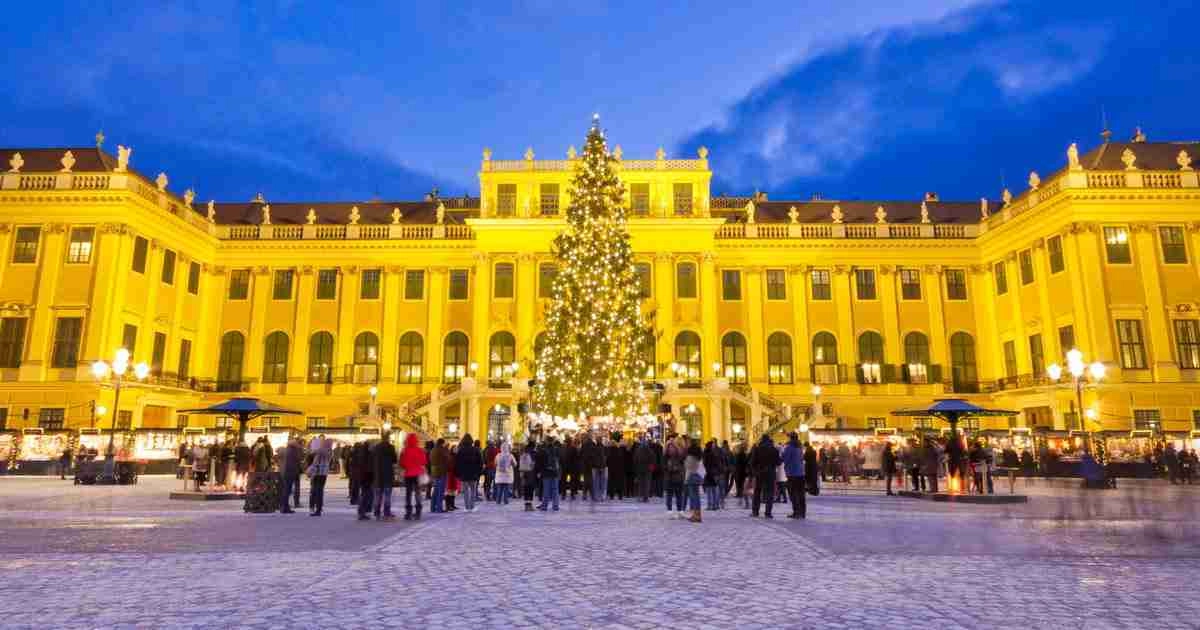
During the spring, the Easter Market at Schönbrunn Palace in Vienna brings the courtyard to life with artisan stalls, traditional Austrian foods, and live music, creating a festive atmosphere that draws locals and tourists alike. As the flowers in the palace gardens begin to bloom, the palace becomes a focal point for celebrations of renewal and joy. Summer at Schönbrunn is marked by open-air concerts held in the Great Parterre, where the Vienna Philharmonic's annual summer night concert is a highlight, offering breathtaking performances under the stars, surrounded by the palace's baroque architecture.
Autumn brings a different charm to Schönbrunn, with the palace hosting the harvest festival which showcases rural Austrian traditions, local crafts, and seasonal foods, allowing visitors to experience Austria's agricultural heritage. As winter approaches, the Christmas Market at Schönbrunn Palace becomes a magical destination. The palace's front courtyard is transformed into a winter wonderland, featuring booths selling handmade crafts, warm drinks, and traditional treats, all under the glow of festive lights. The majestic setting of the palace, coupled with the seasonal cheer, makes this one of Vienna's most beloved holiday traditions.
These seasonal events and festivities at Schönbrunn Palace not only offer a glimpse into Austria's cultural traditions but also allow visitors to engage with the historical legacy of Schönbrunn Palace in Vienna in a dynamic and immersive way. Whether it's through the joyous melodies of a summer concert, the festive spirit of the Christmas market, or the communal warmth of the harvest festival, Schönbrunn Palace remains a year-round destination for those looking to experience the essence of Viennese culture and history.
Bags and Photography rules inside and outside
When visiting the Palace, it's important to be aware of the specific guidelines regarding bags and photography to ensure a smooth experience. Here's a summary of what to expect:
Bag Restrictions: Backpacks and larger bags are not permitted inside the Palace. Visitors will need to check these items at a designated area before entering. This is a common practice at many historic and cultural sites to protect the interiors and exhibits from accidental damage.
Photography Policies: In general, inside the Palace, photography is strictly prohibited. This rule is enforced to preserve the condition of the artworks, interiors, and to maintain a respectful atmosphere for all guests. If you bring a camera, expect to check it along with your larger bags before you tour the Palace interiors.
- If you would like to take pictures and video recording: During opening hours, filming and photography is generally permitted in the state rooms. The use of tripods, selfie sticks or similar photographic or video equipment is prohibited at the Palace, as is the use of flash and similar forms of lighting. Any photos or videos taken may only be used for personal, non-commercial purposes. You need a Permit for current reporting, documentaries, photo shoots and film projects. Please contact the Film and Photo Team at least 3 weeks before your planned project start.
If you are a professional photographer and want to take professional pictures: All film and photo recordings at the Schönbrunn Group’s locations require a Permit. Use our film and photo request form for this purpose (please inform us of your project at least 3 weeks before the planned start).Photographs of the Schönbrunn site may not be marketed and sold via commercial picture agencies. Advertising films and photos, and presentations of any kind (cars, fashion, …) only on request. For more information, please contact the Film and Photo Team.
Photography in the Grounds: While interior photography is not allowed, taking photos in the palace grounds is not only permitted but encouraged. The exteriors and the surrounding gardens often provide stunning backdrops for photographs. This allows visitors to capture memories of their visit without compromising the preservation policies of the Palace's interiors.
- The use of drones or other remote-controlled aircraft is prohibited on the grounds of Schönbrunn Palace.
Before your visit, it's a good idea to check the official website or contact the Palace's visitor services for any updates or changes to these policies. This preparation will help ensure that your visit is enjoyable and hassle-free.
Visitor Information: Tips and Tricks
Planning a visit to Schönbrunn Palace can be overwhelming due to its size and the variety of attractions. This section offers practical advice on how to make the most of your visit, from the best times to go to tips on avoiding the crowds.
- Entering with Vienna Pass: When utilizing the Vienna Pass for entry, it's important to be aware that direct scanning of your pass at the Palace's main entrance isn't possible. Instead, a tangible paper pass is required. Therefore, ensure you secure your paper pass from the welcome center prior to advancing towards the palace premises.
- Make your way to the Gloriette. Embrace the ascent—it promises rewards unparalleled! At its zenith, an elevated vantage point awaits, unveiling panoramic vistas that stretch across the city's expanse, leaving onlookers in awe.
- Labyrinth: Immerse yourself in a world of wonder where the Maze and Labyrinth beckon, particularly captivating for the younger adventurers. Nestled within these winding paths, you'll stumble upon whimsical art installations and engaging musical interactives that spring to life at the heart of the journey. While adults can find their own slice of enjoyment, be prepared to navigate through the exuberant energy of spirited youngsters—consider this as part of the adventure.
- A lot of walk: Brace yourself for a journey on foot; the path from the entrance to the living quarters demands endurance. For visitors facing challenges with mobility, the Schonbrunn train presents a viable alternative, easing the trek across vast distances. This service is priced at 8 euros per person for a day's access, 6 euros for children, or it comes at no extra cost with your Vienna Pass.
- Go Early to experience Schönbrunn Palace without the crowds
FAQs on Schönbrunn Palace
What is Schönbrunn Palace?
Schönbrunn Palace is a former imperial summer residence located in Vienna, Austria. It is one of the most important cultural monuments in the country, renowned for its historic architecture, beautiful gardens, and the cultural events it hosts. The palace and gardens illustrate the tastes, interests, and aspirations of successive Habsburg monarchs.
When was Schönbrunn Palace built?
The construction of Schönbrunn Palace began in the 17th century under Emperor Leopold I and was transformed into a magnificent summer residence by Maria Theresa in the mid-18th century. The palace as it stands today largely reflects the designs from this era.
How many rooms are there in Schönbrunn Palace?
Schönbrunn Palace boasts over 1,441 rooms, with 40 of them open to the public. These include the Imperial Apartments, the Sisi Museum, and the rooms occupied by Franz Joseph and Elisabeth.
Can you visit Schönbrunn Palace?
Yes, Schönbrunn Palace is open to visitors year-round. Guests can explore various parts of the palace, including the state rooms and private apartments of the imperial family, through different types of tickets and guided tours.
Is there an entrance fee for Schönbrunn Palace?
Yes, there is an entrance fee for visiting Schönbrunn Palace. Prices vary depending on the type of ticket purchased, which can include access to the palace, the gardens, the zoo, and other attractions on the grounds. Discounts may be available for children, students, and seniors.
What are the opening hours of Schönbrunn Palace?
The opening hours of Schönbrunn Palace vary throughout the year, generally opening at 9:00 AM. Closing times can vary from 5:00 PM to 6:30 PM depending on the season. It is advisable to check the official website for the most current information.
What attractions are there in the Schönbrunn Palace gardens?
The gardens of Schönbrunn Palace are a highlight, featuring the Gloriette, a Roman ruin, the Neptune Fountain, and the world's oldest continuously operating zoo, the Tiergarten Schönbrunn. There's also a maze and labyrinth, and the Palm House, which is a large greenhouse.
Can you take pictures inside Schönbrunn Palace?
Photography for personal use is generally allowed inside Schönbrunn Palace without flash or tripod. However, restrictions may apply in certain areas or for special exhibitions, so it's always best to check the visitor guidelines or ask staff on-site.
How can I get to Schönbrunn Palace?
Schönbrunn Palace is easily accessible by public transportation in Vienna. The U4 metro line stops at Schönbrunn station, which is a short walk from the palace entrance. Buses and trams also service the area.
What special events are held at Schönbrunn Palace?
Schönbrunn Palace hosts a variety of events throughout the year, including classical concerts, Christmas and Easter markets, and summer night concerts by the Vienna Philharmonic. Additionally, the palace is a popular venue for weddings and corporate events.
Conclusion: The Lasting Legacy of Schönbrunn Palace
Schönbrunn Palace is more than just a historic site; it's a cultural icon. Its legacy is a blend of architectural beauty, historical significance, and cultural richness, making it a jewel in Vienna's crown and an inspiration for future generations.
Site location: Schönbrunner Schloßstraße 47, 1130 Wien
GPS coordinates: 48.186799, 16.313117
Google Photos: Click here
Did you find our article interesting? For more content and exciting articles, follow our site where we regularly update our column to showcase the most beautiful cities in Europe!















